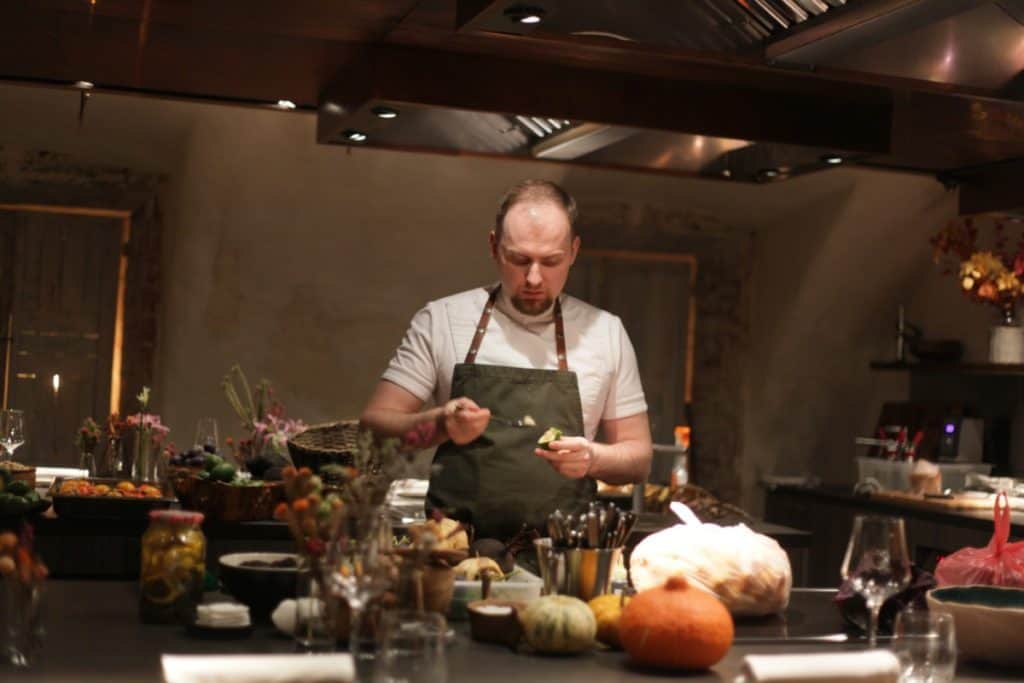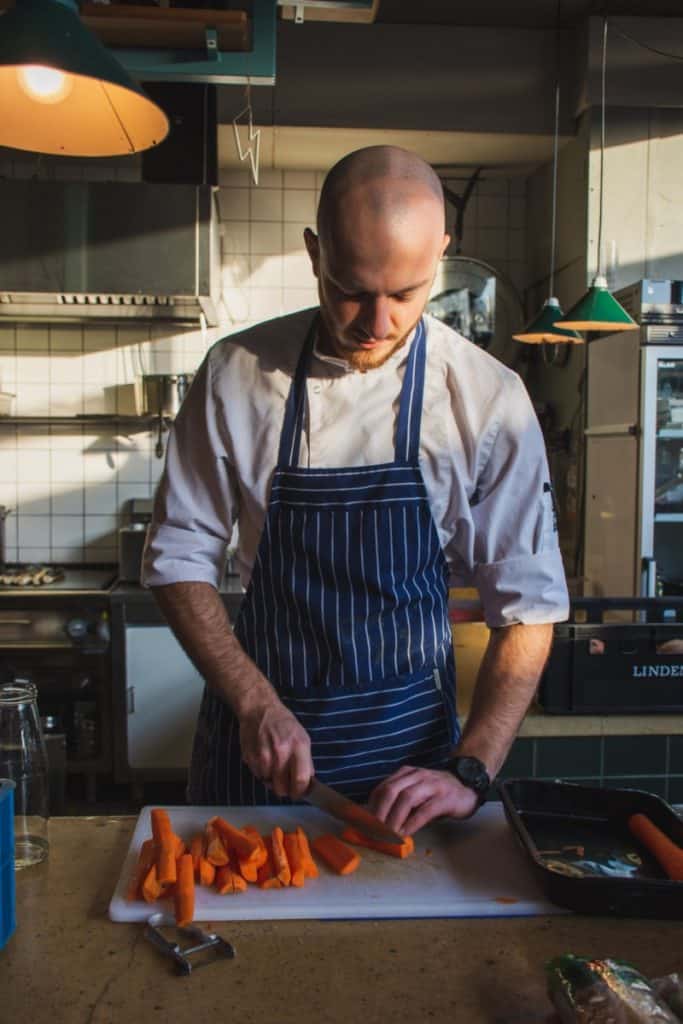
A chef’s uniform has moved on a lot from the days of tall white hats and heavy high button jackets. There are lots of different styles to choose from, not to mention colours. In this article we’ll take a look at the different uniform options open to chefs, what the different chef jacket colours symbolise and which situations each type of uniform are most suitable for.
and heavy high button jackets. There are lots of different styles to choose from, not to mention colours. In this article we’ll take a look at the different uniform options open to chefs, what the different chef jacket colours symbolise and which situations each type of uniform are most suitable for.
Chefs can choose between traditional chef jackets or a standard plain T-shirt, a range of colours for both tops and bottoms, different apron patterns and whether or not to wear a hat. The possibilities are vast but beware because each kitchen has a different policy on the matter.
In this article we will look at the different set ups and what type of uniform is most appropriate for each.
What Do Chef Jacket Colours Mean?
There are no set rules governing which colour jacket a chef can wear. However, the colour black can be associated with a sign of authority, and in some cases only the head chef will be the only chef allowed to wear black.
The head chef will set the rules based on their personal preference. Beginner commis chefs would be better suited to wear white just to be safe.
would be better suited to wear white just to be safe.
The range of chef jacket colours is vast. A chef can choose between white, black, blue, red, pink and many others!
As stated earlier there isn’t a set of rules governing each kitchen. The chefs in the kitchen will make their decisions on what is an appropriate colour from the head chef.
Head chefs prefer one of three things;
prefer one of three things;
- Some like to be the only one wearing black. Black can be seen as a sign of authority. A whole brigade of chefs wearing white, with just the head chef wearing black sends out a powerful image about who is in charge.
- Some prefer that everyone in the kitchen wears white. This is the traditional colour and keeps everyone feeling like they are part of the team. As many work places provide the uniform for their staff, white is often the default colour that they will choose.
- Others are happy for everyone to wear any colour they choose. This means everyone can be dressed in black, white or alternatively any colour the individual chef likes; the more vibrant the better!
In my experience it is best when beginning a chef career
to wear white. No one can be offended by the traditional colour and it gives the new chef time to work out what is most appropriate.
Why Do Chefs Wear White?
Traditionally, white is worn by chefs as it shows any food spillages easier than other colours. This helps prevent any food hygiene issues from dirty clothing. Another reason is that white is a cool colour to wear and helps prevent the chef overheating in the intensity of the kitchen.
As you can see the main reason white is chosen is that it can show dirt easier, helping to prevent food hygiene problems. However, this isn’t true in all cases. Many chefs find that black and other colours are just as good at showing any spilled food stuffs.
problems. However, this isn’t true in all cases. Many chefs find that black and other colours are just as good at showing any spilled food stuffs.
Imagine the mess when flour gets spilled onto a black chef jacket!
In modern times the hygiene reason is also less of a concern due to the industry standards with regard to clean clothing. All chef’s uniforms are washed at the end of every shift regardless of the colour that they are.
The food standards agency does not stipulate which chef colours should be worn, only that they are in a clean condition at the start of every shift.
does not stipulate which chef colours should be worn, only that they are in a clean condition at the start of every shift.
It was also traditionally thought that a great chef should not spill anything, and therefor the white clothing should be as clean at the end of the shift as at the start.
In my experience, this dated view of what makes a great chef has largely passed. Modern chef’s focus far more on pushing the boundaries of cuisine and enhancing the customer experience. They are less inclined to worry about the old traditions and hence why many top chefs allow their brigade to wear t-shirts and aprons instead of the traditional uniform.
Do The Different Chef Jacket Colours Signal Hierarchy?
The different coloured chef uniforms do not indicate hierarchy as a rule. There are no set guidelines regarding colour choice and each kitchen has a different view on acceptable uniform. However, any new chef should check the Head Chef’s personal preference, as black can be seen by some to be superior.
Some kitchens may ask the chefs on each section to wear a different colour to segregate themselves, but this is rare.
to wear a different colour to segregate themselves, but this is rare.
If the Head Chef is wearing white, I would be very surprised to see any of the other chefs wearing black.
Advantages and Disadvantages Of Different Chef Jacket Colours
If you are in a kitchen with free rein to choose which ever colour jacket you like, it will be useful to know the pros and cons of each colour option. For the purposes of this comparison I have grouped any colour that isn’t white into the category of ‘darker colours’
Pros of Darker Chef Uniform Colours:
- Darker colours show the debris less obviously, so a chef can look smart even at the end of a long shift.
- They give a modern look to a kitchen without the stuffiness associated with traditional chef whites.
- Can wash the tops at the same time as the dark coloured aprons and the trousers.
Cons Of Darker Chef Uniform Colours:
- A chef may buy a whole range of darker uniform but then change to a kitchen which insists on their chefs wearing white. All their uniform would be wasted.
- By showing the dirt less obviously it may cause a food hygiene issue.
- Darker colours get hotter. Anyone who’s sat in the sun in a dark t shirt will know how hot it can get. A kitchen can get very hot so this is a consideration.
Pros of White Chef Uniform:
- The traditional chef colour that has been worn for many years, why change the tradition?
- White helps to stay cool in a hot kitchen.
- Shows any dirt and debris clearly; preventing any food hygiene problems.
- Can be worn in any kitchen. It is unlikely that a head chef will take offence to one of their chefs choosing to wear white, even if everyone else is wearing darker colours.
Disadvantages of White Chef Uniform:
- Can look scruffy after a long day in the kitchen. White definitely shows up every last mishap the chef has had!
- Ideally the tops need to be washed separately from the darker trousers and aprons. If not the whites go an off-white colour which doesn’t give off a good image.
- Can look old fashioned in today’s modern kitchens.
So that’s the main advantages and disadvantages covered. During my chef career I always stuck to white as that’s the colour I started with and never felt the need to change. However, I notice most modern kitchens now are favouring alternative colours.
I always stuck to white as that’s the colour I started with and never felt the need to change. However, I notice most modern kitchens now are favouring alternative colours.
Do Chefs Have To Wear Jackets?

Chefs do not have to wear a traditional cotton jacket and many choose not to. In recent years the traditional uniform is becoming less popular as more chefs are choosing to wear plain t-shirts.
This has been popularised by celebrity chefs such as Tom Kerridge , who favour the more casual approach. A plain t-shirt coupled with a pair of chef trousers and an apron is an accepted look now in many kitchens.
, who favour the more casual approach. A plain t-shirt coupled with a pair of chef trousers and an apron is an accepted look now in many kitchens.
A T-shirt has the advantage that it is lighter weight so helps the chef to keep cooler. Another benefit is that chef jackets can be expensive where as a chef can pick up lots of plain T-Shirts for very little money.
Modernising the chef uniform is a good thing in my opinion as it can only help to encourage more people into a kitchen career. My personal view is that a T-shirt and apron looks smart and is practical to work in.
What Colour Trousers Do Chefs Wear?
When keeping things traditional a chef will wear blue and white check trousers. However it is common now to see plain black trousers on most kitchen staff. The colour of the trousers are decided by each individual chef and does not have a bearing on kitchen hierarchy.
Having said it does not demonstrate a kitchen hierarchy , it would be wise for a new chef to stick to either black, or blue and white checked trousers. Turning up for your first chef in a pair of loud coloured trousers may raise a few eyebrows and not help you blend in very easily.
, it would be wise for a new chef to stick to either black, or blue and white checked trousers. Turning up for your first chef in a pair of loud coloured trousers may raise a few eyebrows and not help you blend in very easily.
Some experienced chefs choose their trouser colour as an outlet for their personality type. Similar to golfers trousers, there are lots of crazy patterns a chef can choose from!
There is no hygiene arguments for favouring one colour trouser over another, however there is regarding the wearing of shorts . All options are darker colours (I’ve never come across a chef in plain white trousers!). Lightweight and comfortable is the main focus.
. All options are darker colours (I’ve never come across a chef in plain white trousers!). Lightweight and comfortable is the main focus.
What Colour Aprons Do Chefs Wear?

The traditional colour for chefs aprons are a blue and white vertical striped pattern. These are still favoured by lots of chefs; however the more common colour now seen in kitchens is black. The colour of the chefs apron does not signal a hierarchy.
As we’ve mentioned with every colour so far; individual chefs have a different view on apron colours. However, this is one area which is not so important. A complete beginner would not look out of place wearing, either a black or blue and white striped apron.
Before spending money on an apron I would check with the kitchen you are entering which colour they would like you to have. However if this is not possible and you need to choose a colour now, I would choose black.
which colour they would like you to have. However if this is not possible and you need to choose a colour now, I would choose black.
To Sum Up
As readers can see as there is no set in stone rules for which colour jacket or style of uniform a chef can wear. This can make the process of choosing a uniform a bit of a mine field.
The best advice I can give is ask the kitchen you are entering on their uniform preference. Many kitchens provide uniform so this is not a concern and they will arrange it all.
If this is not possible then stick to a white top chef jacket, black trousers and black apron. This is the uniform option favoured by many. It won’t look out of place or outdated, and won’t make you stand out for the wrong reasons.
